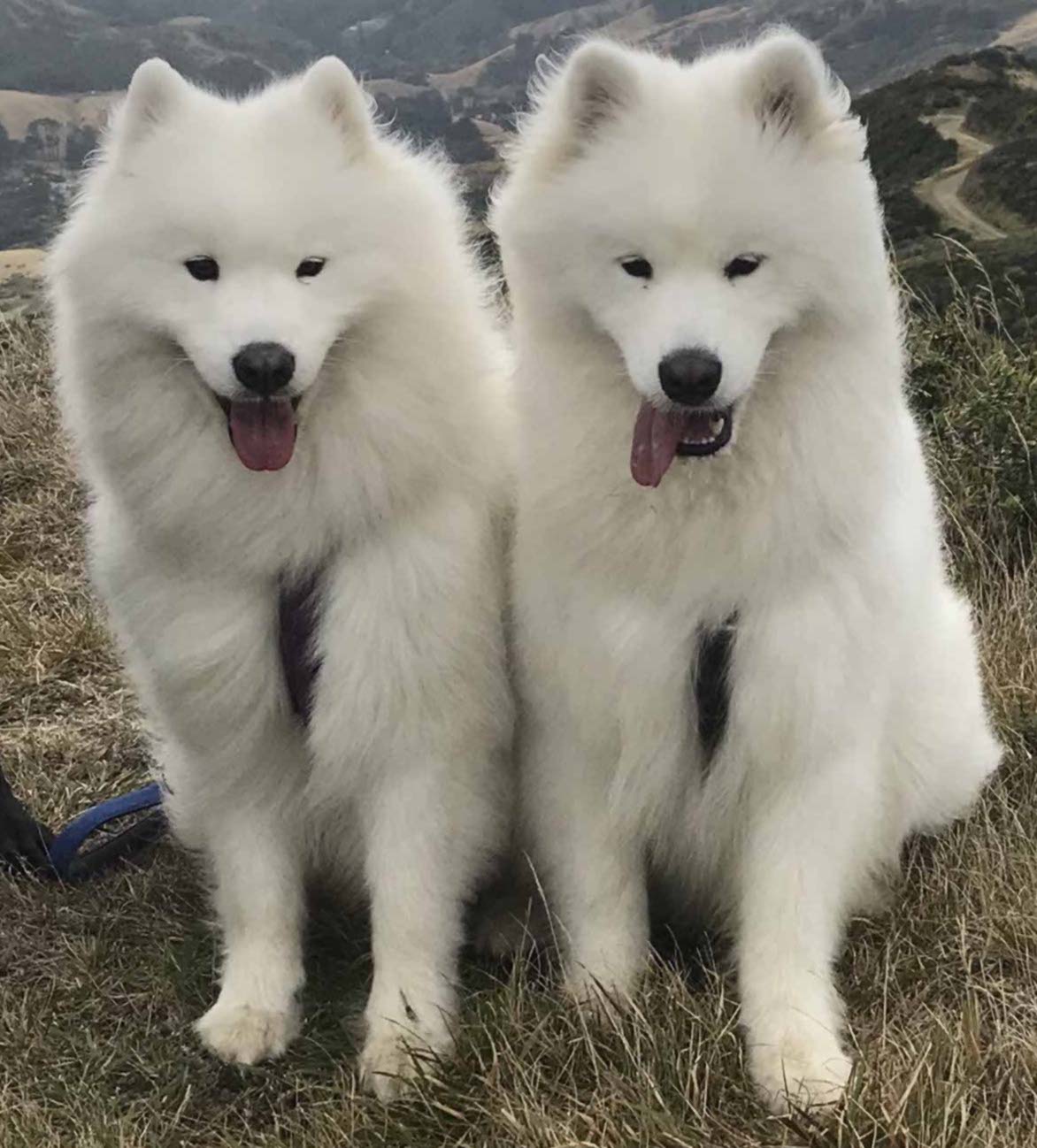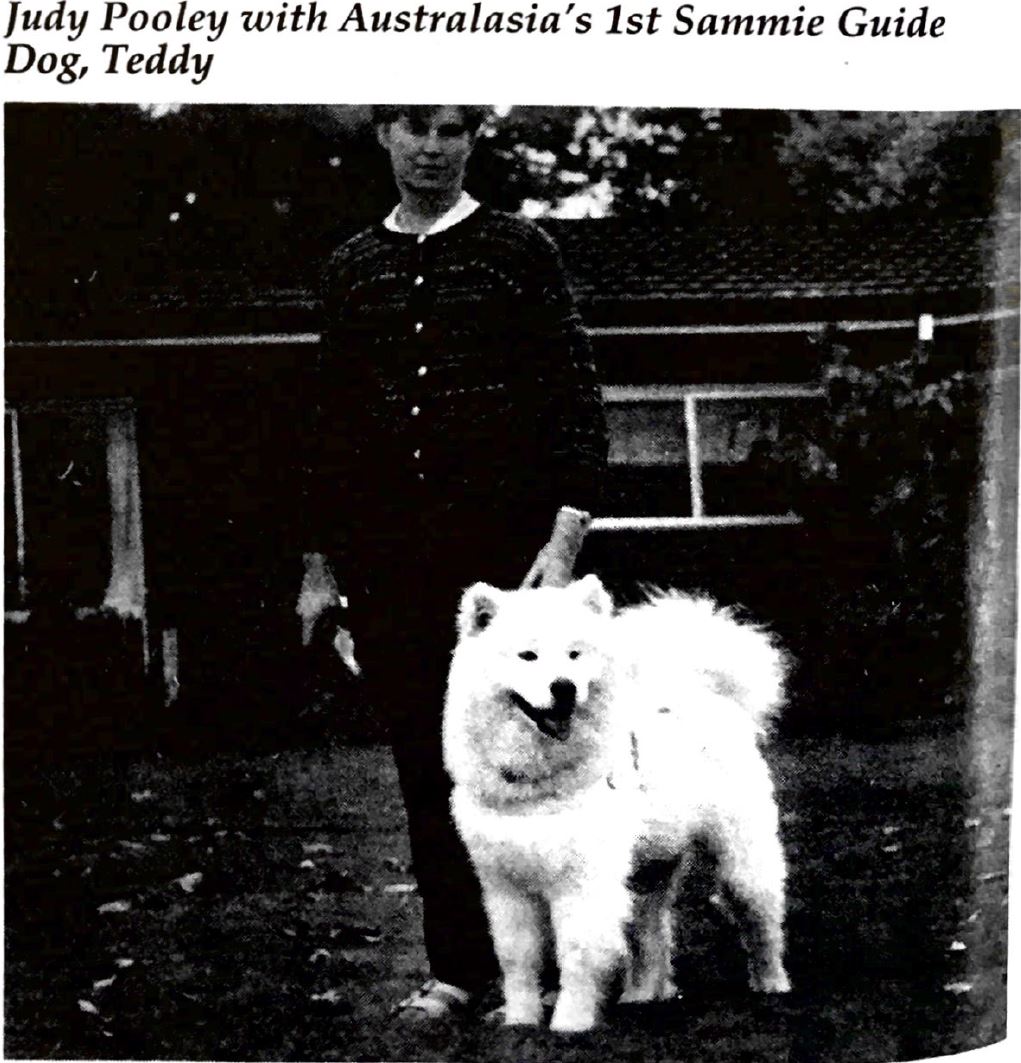For the betterment of the breed.

The Samoyed is an ancient breed originating from Russia and much admired for its beautiful white coat, smiling face, happy disposition and general good health.

THE SAMOYED IN GUIDING
Samoyeds have been used as guide dogs mainly where the owner has a dog already that is trained up to guide. Teddy was a well know Samoyed Guide Dog on the street of Wellington.
“The Guide Dog” by Jacqui Stitt, The New Zealand Samoyed Supplement, NZ Kennel Gazette – June 1993

The Guide Dog
Jacqui Stitt, Guide Dog Trainer, Royal New Zealand Foundation for the Blind Guide Dog Service, continues Teddy’s tale ...
For a memorable six months I had the task of putting Teddy, a fifteen month old Samoyed, through the steps to becoming a guide for his owner, Judy Pooley. Teddy settled well into kennel life, enjoying the company of the other dogs, especially his good pal “Iggy”, a white Standard Poodle. Considering there had been no socialising of Teddy in his earlier days, which is the usual procedure for our pups on the Champ Guide Dog Puppy Development Programme, Teddy took everything in his stride and did not let anything bother him.
Initially the main concern I had with Teddy was his inconsistency to walk out with nice tension on the lead. This was possibly due to the heat so Teddy is now clipped about every six weeks in the summer months.
Apart from this Teddy was a pleasure to train. He is willing to please and always happy in his work. Teddy has a nice degree of confidence and also some self interest. He can be quite a stubborn wee boy at times! Because of his sensitivity the control needed is minimal, which makes life easy.
Teddy has a high degree of initiative and uses it well in his role as a guide. He picked up the work being asked of him with little effort. This was partly due to Teddy's natural awareness to move both left and right for obstacles and people, and he had to remember to leave enough space for me as well!
I have found there is no major difference in training Teddy to training any other of the more popular breeds which are used by the Royal New Zealand Foundation for the Blind. The one problem I had throughout with Teddy was his adorable looks and the public always wanting to speak to him. Of course, Teddy loved this as he knows how handsome he is and enjoys all the attention he receives.
All in all, Teddy was a delight to have and it was an honour for me to have the opportunity to train not only the fifteenth family pet in New Zealand, but also a Samoyed, a breed which is unusual for guide work.
Teddy had an excellent temperament and a wonderful nature. I wish Judy and Teddy all the best for the future.
TEDDY is Australasia's first Samoyed Guide Dog, one of 155 working Guide Dogs in New Zealand. Bronwyn Bendall, daughter of Teddy's breeder, Mrs Alice Commerer of Hamilton profiles this two year old breed pathfinder ....
One of a litter of six sired by NZ Grand Ch & Aust Ch Kimchatka The Godfather ex Kimlana Frosted Silver, Teddy, or Silver Charles of Karmera, was purchased by Judy Pooley at eight weeks old, as a family pet and a companion for her guide dog, Peggy.
She chose him because he was the friendliest and had the softest coat. Mind you, Teddy chose Judy, as every time she stretched out her hand, he was there.
When the Royal New Zealand Foundation for the Blind, Guide Dog Service came to do the second assessment of Judy's old guide dog, after the arrival of Teddy into the family, they asked what plans Judy and Brian had for Teddy. As the Guide Dog Service was short of dogs at their Centre and they were impressed with what they had seen of him, they suggested submitting Teddy for assessment and seeing how things progressed.
Being a very active person Judy was finding her old guide dog was slowing down, so after careful consideration they sent Teddy to Auckland for assessment. He passed and went into training.
Teddy returned to the Poole family in February this year, making him the first Samoyed guide dog in New Zealand and the only working Samoyed in the world, according to Chris Orr, Publicity and Fund Raising Officer for the Royal New Zealand Foundation for the Blind, Guide Dog Service.
Teddy has been clipped except for his head, legs and tail to make him easier for Judy to groom.
Completing his training at a later age than Labradors and other guidedogs was probably to Teddy's advantage as Samoyeds tend to mature slowly. Having been a pet before undergoing training helped him to re-adjust to the family on his return although Judy says he was rather quiet for a while as he missed his kennel mates.
Teddy leads a very active life as his owner is Disability Co-ordinator at Waikato Polytechnicand is also studying at the University of Waikato. His day starts as Judy walks her three children to school and kindergarten and then down the street to catch the bus to work. He has a great sense of direction and is very quick to pick up on where he is supposed to lead Judy, especially around the vast maze of buildings at both the University and Polytech.
Teddy is very sociable and outgoing and is just starting to stop when he sees someone he recognises in the street. Judy finds that he attracts a lot of attention and people often ask her what breed he is as they have never seen a Samoyed guide dog before.
Judy and Brian note that one advantage he has over her other guide dogs is that because of the type of hair that Samoyeds have he doesn't smell when he gets wet. Judy also said that she found it easier to remove his hair from her clothing than the hair of the other dogs she has owned.
Although I am not a Samoyed person I found Teddy to be very appealing. One look at him and it is easy to see why the children call him "Mr Bear". He is a very gentle and sensitive animal.
What a wonderful advertisement for the Samoyed as a breed! (See pg 2 for Teddy's photo.)
“The Guide Dog” by Jacqui Stitt, The New Zealand Samoyed Supplement, NZ Kennel Gazette – June 1993
